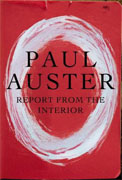Report from the Interior
Paul Auster
book reviews:
· general fiction
· chick lit/romance
· sci-fi/fantasy
· graphic novels
· nonfiction
· audio books
· author interviews
· children's books @
curledupkids.com
· DVD reviews @
curledupdvd.com
newsletter
win books
buy online
links
home
for authors
& publishers
for reviewers

 |
Report from the Interior Paul Auster Henry Holt Hardcover 352 pages November 2013 |
|
Writer extraordinaire Paul Auster has done it again, serving up a surprising work—this time a memoir of his expanding mind. Report from the Interior “…as you walked alone across the newly resurgent grass in Grove Park and felt the warmth of the sun upon your face, you were in an exultant mood, and you felt the need to express that exaltation in words, in written, rhyming words.”Auster abruptly changes gears upon reaching his doubly troublesome college years in the late Sixties (Vietnam War, the draft and protests, as well as the varying living situations, difficult classes, uncooperative professors, deciding your life course, and falling in love that typically occupies college students). He bravely reveals letters written to a girlfriend who later becomes his first wife (now ex, the writer Lydia Davis). Reading these letters allows readers to examine Auster’s mindset, which is slightly disturbing. Was he a struggling phenom? A typical full-of-himself college boy? Adrift in a gone-mad world? Luckily the futures sneaks in: “I have been writing. It makes me feel human.”
Toward the start, sitting in the dark, young Paul watched “….a stick-like Martian appeared, and before the pastor-father could take another step, there was a flash of light, and the bearer of the holy word was turned into a shadow. Soon after that, not even a shadow—turned into nothing at all. God, the all-powerful one, had no power. In the face of evil, God was as helpless as the most helpless man, and those who believed in him were doomed. Such was the lesson you learned that night from The War of the Worlds. It was a jolt you have never fully recovered from.”Like nearly all young people, Auster’s early days were dominated by heroes. Edison in particular carved out a column, especially when the boy found out the local barber, and later revealed his father, had had real contact with the genius. Like most youngsters, his hero plummets. “Your idol turned out to have been a rabid, hate-filled anti-Semite…” who had fired your Jewish father without cause. Readers will grin, grimace, and nod in understanding as Auster navigates the complex early teen years. Auster adeptly captures the angst, the boredom, the waiting for life to begin: “Fourteen, the terrible age of fourteen, when you are still a prisoner of the circumstances you were born into and yet ready to leave them behind, when all you dream about is escape.”Stated on the book jacket as “his development within,” Auster does present an atypical telling of how he came to be a revered writer. Even he seems to be shaking his head at times at the questionable judgment depicted in his youthful ramblings. Auster traces his real writing roots back to a story written and then read aloud to his sixth grade class, thanks to a teacher’s encouragement. Readers will relate to the fact that while a wordly vocation seemed clearly on the cusp, Auster doesn’t yet see it. When discussing his “daze,” Auster recounts the briefest periods of time where he has “this tendency to vanish from your own consciousness. Mysterious and unaccountable, but an essential part of who you were then and occasionally still are now. As if you were slipping into another dimension, a new configuration of time and space, looking at your own life with blank, indifferent eyes…”One can certainly imagine that such a state benefits fiction writing. Auster has already recalled the physical journey of his life in the companion piece to this volume, Winter Journal. He has also pleased readers with other autobiographies and myriad works of fiction such as Sunset Park, Invisible, The Book of Illusions, The New York Trilogy, and my favorites, Timbuktu and Man in the Dark. The prizes for his fiction include the PEN/Faulkner Award for Fiction (The Music of Chance); he is a member of the American Academy of Arts and Letters and several other honorary organizations. Auster has also won an Independent Spirit Award for best screenplay and has directed films including Lulu on the Bridge, an official selection of the Cannes Film Festival. The final section of Report from the Interior Originally published on Curled Up With A Good Book at www.curledup.com. © Leslie Nichols Raith, 2013 |
| Also by Paul Auster: |
|
|
|
 Click here to learn more about this month's sponsor! |
|
| fiction · sf/f · comic books · nonfiction · audio newsletter · free book contest · buy books online review index · links · · authors & publishers reviewers |
|
| site by ELBO Computing Resources, Inc. | |
 Picking up any Auster work inevitably results in surprise: surprise about the subject matter, surprise about the sensitive depictions of humans (and animals) living on the fringe, surprise about the dramatic realizations that drive his characters, or the slow passage of time beautifully revealed. But through all the unique pages written by this talented author, readers have come to feel that they know Auster. With
Picking up any Auster work inevitably results in surprise: surprise about the subject matter, surprise about the sensitive depictions of humans (and animals) living on the fringe, surprise about the dramatic realizations that drive his characters, or the slow passage of time beautifully revealed. But through all the unique pages written by this talented author, readers have come to feel that they know Auster. With